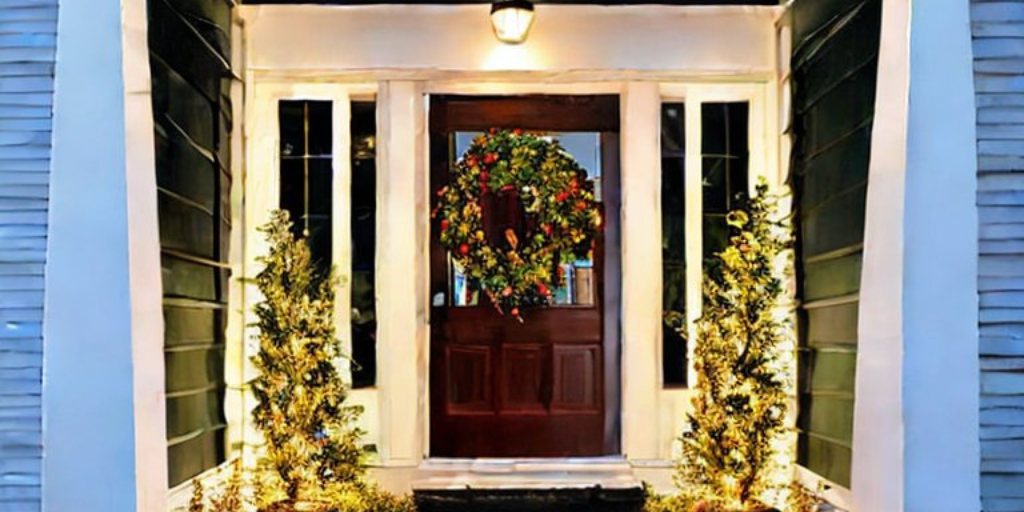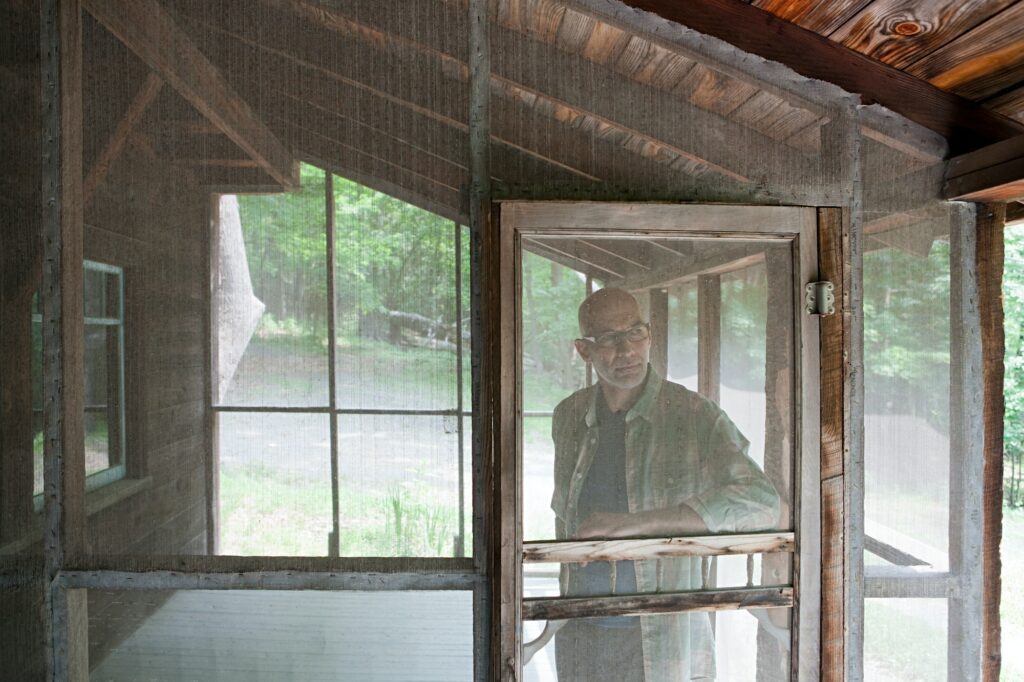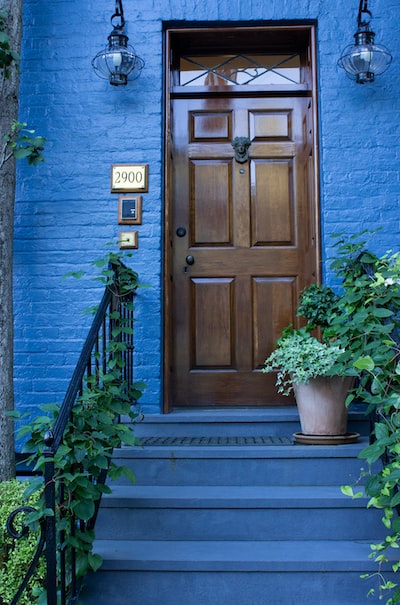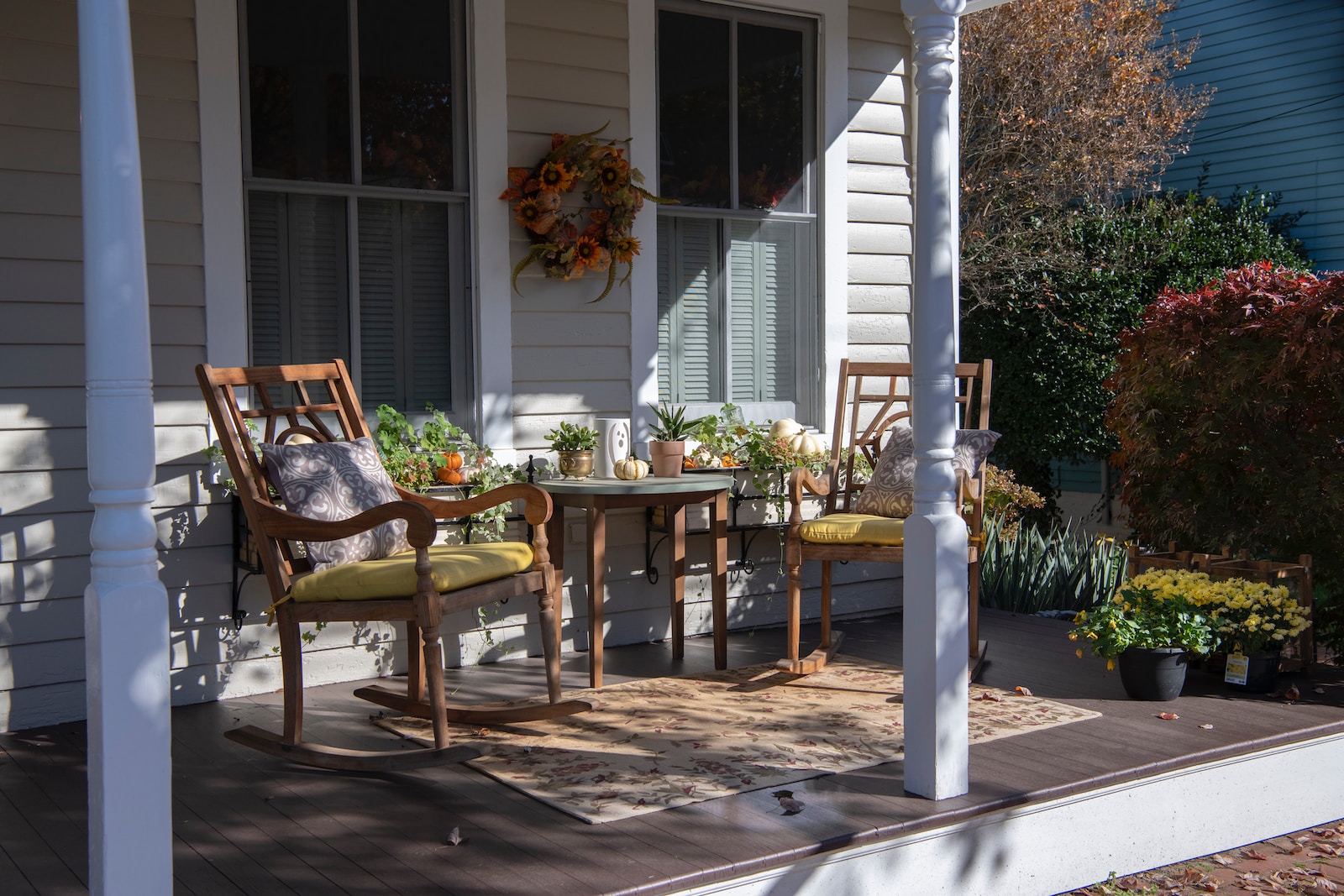Have you ever asked what are some safety considerations for porch lighting installation? If you have, then you will find this guide informative and helpful to your many questions. When installing porch lighting, it’s important to keep safety in mind.
Not only can poor installation lead to functional issues with the lighting, but it can also pose a risk of electrical shock or fire. By taking the necessary safety considerations into account, you can ensure that your porch lighting installation is safe, secure, and functional. Below area number of questions and answers that relate to this topic, so become better informed!
What are some safety considerations for porch lighting installation?
Contents
- 1 What are some safety considerations for porch lighting installation?
- 2 How to install porch lighting safely?
- 3 What tools are needed for porch lighting installation?
- 4 How to choose the right outdoor lighting fixtures for porch?
- 5 What are the local building codes for porch lighting installation?
- 6 How to secure wiring for porch lighting installation?
- 7 What are the risks of improper porch lighting installation?
- 8 How to turn off power before porch lighting installation?
- 9 How to prevent electrical shock during porch lighting installation?
- 10 How to test porch lighting for safety?
- 11 How to install motion-sensor porch lighting safely?
- 12 How to avoid fire hazards during porch lighting installation?
- 13 Final thoughts on what are some safety considerations for porch lighting installation
When it comes to porch lighting installation, safety should always be a top priority. Here are some important safety considerations to keep in mind:
Choose the right lighting fixtures: Make sure to choose outdoor lighting fixtures that are specifically rated for outdoor use and are appropriate for the size and type of your porch. The fixture should also be UL-listed for safety.
Turn off the power: Before beginning the installation process, turn off the power to the porch by switching off the circuit breaker or removing the fuse. This will prevent the risk of electrical shock.
Use the proper tools: Use the right tools and equipment for the job, and make sure they are in good working condition. This includes tools such as wire strippers, pliers, and a voltage tester.
Use the correct wiring: Use only wiring that is rated for outdoor use and is appropriate for the power load of the lighting fixture. Make sure to follow local building codes and regulations.
Secure the wiring: Make sure to properly secure the wiring in place to prevent it from becoming loose or damaged. Use cable ties or clips to secure the wiring along the path of the installation.
Keep the wiring away from water: Make sure to route the wiring away from areas where it may be exposed to water, such as rain gutters or downspouts. This will help prevent electrical shock and other hazards.
By following these safety considerations, you can ensure that your porch lighting installation is safe and secure, while also providing functional and attractive lighting for your porch. Remember, if you are not comfortable with the installation process or have any doubts about your ability to do it safely, it’s always best to consult a professional electrician.
How to install porch lighting safely?
Installing porch lighting requires proper planning and execution to ensure a safe and successful installation. Here are the steps to install porch lighting safely:
Turn off the power: Before starting any installation work, turn off the power to the porch light by switching off the circuit breaker or removing the fuse. This will prevent electrical shock.
Choose the right lighting fixture: Choose an outdoor lighting fixture that is appropriate for your porch size and type, and that is UL-listed for safety.
Use the proper wiring: Use wiring that is rated for outdoor use and that can support the power load of the lighting fixture. Follow local building codes and regulations.
Attach mounting bracket: Attach the mounting bracket to the electrical box using screws and a screwdriver. Make sure the bracket is secure and can hold the weight of the lighting fixture.
Connect wiring: Connect the wiring from the lighting fixture to the wiring from the electrical box, following the manufacturer’s instructions. Use wire connectors to secure the wiring and protect against electrical shorts.
Secure fixture: Mount the fixture onto the bracket using screws and a screwdriver. Make sure the fixture is secure and level.
Test lighting: Turn the power back on and test the lighting to ensure it is functioning properly.
Properly dispose of materials: Dispose of any unused or excess materials, such as wiring or mounting hardware, in an appropriate manner.
By following these steps, you can install porch lighting safely and successfully, providing both functional and aesthetic benefits to your porch. Remember, if you are not comfortable with the installation process or have any doubts about your ability to do it safely, it’s always best to consult a professional electrician.
What tools are needed for porch lighting installation?
Installing porch lighting requires a few basic tools to ensure a safe and successful installation. Here are some of the tools you may need:
Screwdriver: You will need a screwdriver to attach the mounting bracket to the electrical box and to mount the lighting fixture onto the bracket.
Wire stripper: A wire stripper is used to remove the insulation from the end of the electrical wires to make a proper connection.
Wire connectors: Wire connectors are used to secure the wiring and protect against electrical shorts.
Drill: If the mounting bracket does not fit the electrical box, you may need to drill new holes to secure it properly.
Voltage tester: A voltage tester is used to ensure that the power is off before starting any work.
Ladder: You will likely need a ladder to reach the porch ceiling and install the lighting fixture.
Pliers: Pliers are useful for tightening wire connectors and making sure all connections are secure.
Tape measure: A tape measure is useful for ensuring that the lighting fixture is installed at the correct height and distance from the wall.
Utility knife: A utility knife can be used to cut the wire or to strip the insulation from the wire.
By having these tools on hand, you can make sure you have everything you need to install porch lighting safely and successfully.
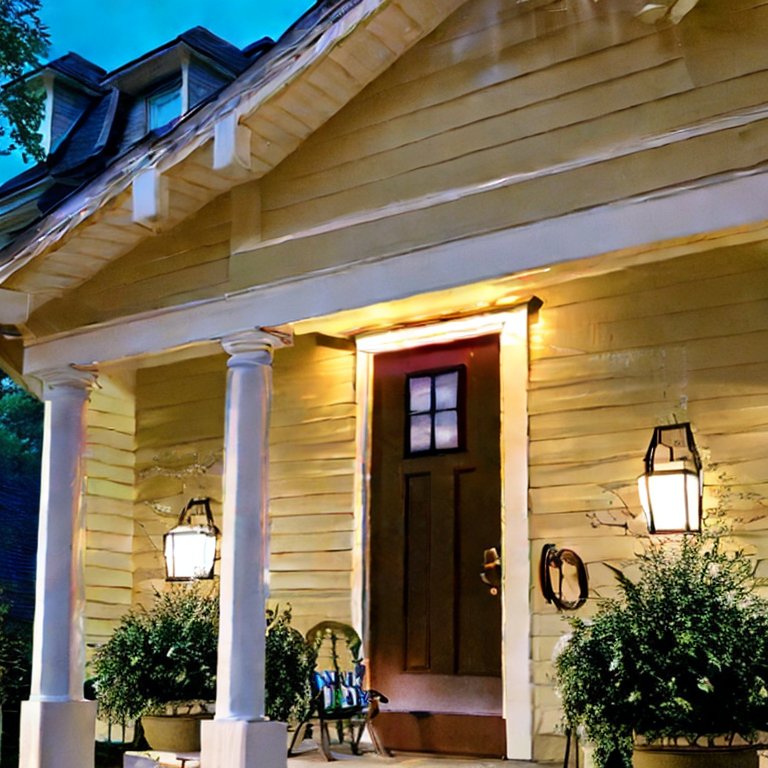

How to choose the right outdoor lighting fixtures for porch?
Choosing the right outdoor lighting fixtures for your porch is essential to ensure both safety and aesthetic appeal. Here are some factors to consider when choosing outdoor lighting fixtures for your porch:
Porch size and style: The size and style of your porch will play a significant role in determining the type and size of lighting fixtures that are appropriate. A larger porch may require more than one fixture, while a smaller porch may need just one.
Location and weather conditions: The location of your porch and the local weather conditions will also play a role in determining the right lighting fixture. If your porch is exposed to harsh weather conditions, choose a fixture that is weather-resistant and designed for outdoor use.
Power source: The power source for your porch lighting will determine the type of fixture that is appropriate. If you want to use solar-powered lighting, for example, you will need to choose a fixture that is designed for that power source.
Style and design: The style and design of your outdoor lighting fixtures should complement the overall aesthetic of your porch and your home. Choose a fixture that matches the style and design of your home’s exterior and your personal preferences.
Light output: Consider the amount of light output you need for your porch. If you want a well-lit porch, you may need a fixture with higher light output, while a more ambient or subdued light may require a lower output.
Energy efficiency: Consider energy-efficient options when choosing lighting fixtures. LED fixtures, for example, are more energy-efficient than traditional incandescent bulbs and can save you money in the long run.
By considering these factors, you can choose the right outdoor lighting fixtures for your porch that will provide both safety and aesthetic appeal.
What are the local building codes for porch lighting installation?
Local building codes for porch lighting installation vary depending on the location and jurisdiction. It is important to check with your local building department to determine the specific requirements for your area.
Generally, building codes for porch lighting installation require compliance with the National Electrical Code (NEC) and may include regulations such as:
Minimum distance between the light fixture and surrounding surfaces, such as walls, ceilings, and floors.
Maximum wattage for the light fixture and type of bulb that can be used.
Minimum height of the light fixture above the walking surface of the porch.
Proper wiring and electrical connections.
Use of weather-resistant materials and fixtures designed for outdoor use.
Compliance with energy efficiency standards, such as use of LED bulbs.
It is important to ensure that your porch lighting installation meets all local building codes to avoid safety hazards, potential fines, and problems with selling your home in the future. Contact your local building department for specific requirements and obtain necessary permits before starting any porch lighting installation.
How to secure wiring for porch lighting installation?
Securing wiring for porch lighting installation is crucial for safety and compliance with building codes. Here are the general steps for securing wiring:
Use proper wire connectors: Use wire connectors that are appropriate for the wire size and number of wires being connected. Twist the wires together before inserting them into the connector, and make sure the connection is secure.
Use cable clamps: Use cable clamps to secure the wiring to the electrical box and to prevent the cable from being pulled out of the box. The clamps should be installed securely and tightened to hold the cable firmly in place.
Route wiring away from heat sources: Make sure to route the wiring away from any heat sources, such as exhaust vents or light fixtures, to avoid potential damage or fire hazards.
Use protective tubing: If the wiring is exposed to sharp edges or rough surfaces, use protective tubing to prevent the wiring from being damaged.
Follow local building codes: Be sure to follow local building codes and regulations for wiring installation to ensure safety and compliance.
It is important to make sure wiring for porch lighting installation is secured properly to avoid safety hazards and ensure compliance with building codes. If you are unsure about how to secure wiring or have any concerns about your porch lighting installation, consult a licensed electrician for professional advice.
What are the risks of improper porch lighting installation?
Improper porch lighting installation can pose significant risks to both property and personal safety. Here are some potential risks associated with improper installation:
Fire hazard: Improper installation can lead to overheating, electrical shorts, or other electrical problems that can create a fire hazard.
Electrical shock: If wiring is not properly secured or insulated, it can cause electrical shock to anyone who comes into contact with the wiring.
Damage to fixtures and property: Improperly installed fixtures or wiring can cause damage to property or the fixtures themselves, which can lead to costly repairs or replacement.
Inefficient lighting: Improper installation can lead to inefficient lighting that does not adequately light the porch, making it difficult to see and navigate.
Code violations: If installation is not done in accordance with local building codes, it can result in code violations, potential fines, and even problems with selling the home in the future.
To ensure proper installation and avoid these risks, it is important to follow manufacturer instructions, consult with a licensed electrician if needed, and adhere to local building codes and regulations.
Properly installed porch lighting can provide a safe and welcoming environment for outdoor activities while enhancing the aesthetic appeal of the property.
How to turn off power before porch lighting installation?
Turning off the power before porch lighting installation is crucial for safety. Here are the general steps for turning off the power:
Locate the circuit breaker box: The circuit breaker box is usually located in a utility room, garage, or basement. Identify the circuit breaker that controls the power to the porch lighting and turn it off.
Confirm the power is off: After turning off the circuit breaker, use a non-contact voltage tester to confirm that the power is off. Hold the tester near the wiring and it will indicate whether or not there is any voltage present.
Double-check: Double-check to make sure that the power is off before beginning any work on the porch lighting.
It is important to turn off the power before porch lighting installation to avoid the risk of electrical shock or other safety hazards. If you are unsure about how to turn off the power or have any concerns about your porch lighting installation, consult a licensed electrician for professional advice.
How to prevent electrical shock during porch lighting installation?
Installing porch lighting can be a potentially hazardous task if proper precautions are not taken. To prevent electrical shock during porch lighting installation, you can follow the following safety measures:
Turn off the power: Before you start the installation, turn off the power to the porch lighting circuit at the breaker box or fuse panel. Make sure to verify that the power is off using a voltage tester.
Use appropriate tools: Use only tools that are approved for electrical work, and make sure they are in good condition.
Wear protective gear: Wear rubber-soled shoes or boots, gloves, and safety goggles to protect yourself from electrical shock.
Keep the area dry: Make sure the area where you are working is dry. Do not install porch lighting in wet conditions or during rain.
Use a ladder safely: Use a stable ladder that is tall enough to reach the area you need to work on, and make sure it is on a level surface. Don’t overreach or stand on the top rungs of the ladder.
Follow the manufacturer’s instructions: Follow the instructions provided by the manufacturer of the porch lighting fixture carefully, and make sure you understand them before beginning the installation.
Hire a professional: If you are not confident in your ability to install porch lighting safely, it is always better to hire a licensed electrician to do the job for you.
By following these safety measures, you can help ensure that you install your porch lighting safely and without the risk of electrical shock.


How to test porch lighting for safety?
Testing porch lighting for safety is an important step to take to ensure that the lighting fixture is functioning properly and there are no potential safety hazards. Here are some steps to test porch lighting for safety:
Turn off the power: Turn off the power to the porch lighting circuit at the breaker box or fuse panel.
Inspect the fixture: Inspect the fixture for any visible damage, such as cracks, exposed wires, or loose connections. If any damage is found, do not proceed with the testing and repair or replace the fixture.
Replace bulbs: Replace any burnt-out bulbs with the correct wattage recommended by the manufacturer.
Turn on the power: Turn the power back on at the breaker box or fuse panel.
Test the switch: Flip the switch to turn the porch light on and off several times to make sure it is working correctly.
Check for proper grounding: Test the grounding of the fixture using a voltage tester. Touch one lead of the tester to the metal housing of the fixture and the other to a known ground source, such as a metal water pipe or a grounding wire. If the tester indicates that there is no ground or a weak ground, turn off the power and consult an electrician to correct the issue.
Test for adequate light: Check that the fixture is providing adequate light to the area it is intended to illuminate.
By following these steps, you can help ensure that your porch lighting is functioning properly and safely. If you notice any issues during testing, do not hesitate to consult an electrician for further assistance.
How to install motion-sensor porch lighting safely?
Installing motion-sensor porch lighting can help provide an added layer of security to your home, but it is important to do so safely to prevent any potential hazards. Here are the steps to install motion-sensor porch lighting safely:
Turn off the power: Turn off the power to the porch lighting circuit at the breaker box or fuse panel.
Select the right fixture: Choose a motion-sensor porch lighting fixture that is rated for outdoor use and has the features you want, such as sensitivity and duration of light.
Gather the necessary tools: Gather the necessary tools for installation, including a voltage tester, wire stripper, pliers, screwdriver, and wire nuts.
Remove the existing fixture: Remove the existing porch light fixture and disconnect the wires by unscrewing the wire nuts and separating the wires.
Install the mounting bracket: Attach the mounting bracket for the motion-sensor fixture to the electrical box using the provided screws.
Connect the wiring: Connect the wires from the motion-sensor fixture to the wires in the electrical box using wire nuts. Match the black wires, white wires, and ground wires together.
Mount the fixture: Secure the motion-sensor fixture to the mounting bracket using the provided screws.
Adjust the settings: Adjust the sensitivity and duration settings on the motion sensor according to the manufacturer’s instructions.
Turn on the power: Turn the power back on at the breaker box or fuse panel.
Test the light: Test the light by walking in front of the motion sensor to make sure it turns on and off correctly.
By following these steps and taking necessary safety precautions, you can install motion-sensor porch lighting safely and help increase the security of your home. If you are not confident in your ability to install the fixture, it is always best to hire a licensed electrician to do the job for you.
How to avoid fire hazards during porch lighting installation?
Installing porch lighting can greatly enhance the look and safety of your home’s exterior, but it’s important to take steps to avoid fire hazards during the installation process. Here are some tips to help you avoid fire hazards:
Choose the right type of lighting: Make sure that the lighting you choose is suitable for outdoor use and is labeled as “weatherproof” or “outdoor-rated.”
Use proper wiring: Use wiring that is rated for outdoor use and has the appropriate insulation. This will help prevent shorts and other electrical problems that can lead to fires.
Hire a licensed electrician: If you’re not comfortable working with electrical wiring, it’s best to hire a licensed electrician to install your porch lighting. They have the necessary skills and knowledge to ensure that your installation is safe and up to code.
Keep flammable materials away from lights: Be sure to keep flammable materials such as curtains, plants, and furniture away from your porch lighting. This will reduce the risk of a fire starting if the lights get too hot.
Don’t overload circuits: Be careful not to overload circuits by connecting too many lights to one circuit. This can cause the wiring to overheat and potentially start a fire.
Use LED lights: LED lights are cooler and more energy-efficient than traditional incandescent bulbs. They also last longer and are less likely to overheat and cause a fire.
By following these tips, you can help ensure that your porch lighting installation is safe and free from fire hazards.
Final thoughts on what are some safety considerations for porch lighting installation
What are some safety considerations for porch lighting installation may seem challenging, but the information above should help tremendously. Installing porch lighting can be a great way to improve the functionality and aesthetics of your home’s exterior.
However, it’s important to prioritize safety throughout the installation process. By following the proper guidelines and taking the necessary precautions, you can install porch lighting safely and with confidence, while adding an extra layer of security to your home.
